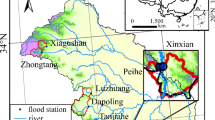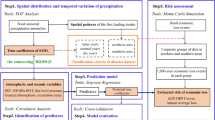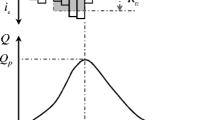Abstract
Affected by human activities, land use and land cover has changed in Daqinghe watershed, China, which resulted in varied runoff. In many hydrological stations, there was a decreasing trend of flood volume and flood peak, but no trend of rainfall depth. In order to quantify the effect of land use change on flood peak and volume, we selected 5 sub-watersheds in Daqinghe watershed, and made a multi-linear regression analysis incorporating the main information in the selected sub-watersheds. The dependent variables are changes in flood volume and flood peak, and the independent variables are the control factors including changes in rainfall depth, intensity, land use area, watershed area, and so on. The rainfall and flood data series are from 1956 to 2005. We divided the data into 2 groups according to flood size―greater than and less than 10 year return period. At last, 4 regression equations were obtained. Based on the multi-linear regression equations and land use data of 1970, 1980, 1995 and 2000, the quantified effects of land use change on flood peak and volume were obtained. Compared with 2000 land use condition, flood volume and peak varied larger in 1970 and 1995 land use conditions, but slightly in 1980 land use condition. Take Zijingguan as an example, flood volume greater than 10 year return period increased 4.08 mm in 1970 land use and decreased 4.90 mm in 1995 land use, but just increased 0.12 mm in 1980 land use. Among all the selected sub-watersheds, land use change had a significant effect on both flood volume and peak in Zijingguan and Zhangfang sub-watersheds. And Manshuihe showed a large variation in 1970 land use condition, other sub-watersheds exhibit a moderate variation due to land use change.



Similar content being viewed by others
References
Andréassian V (2004) Water and forests: from historical controversy to scientific debate. J Hydrol 29:1–27
Austin SA (1999) Streamflow response to forest management: a meta-analysis using published data and flow duration curves. Colorado State University, CO
Bathurst JC, Birkinshaw SJ, Cisneros F et al (2011) Forest impacts on floods due to extreme rainfall and smowmelt in four latin American environments 2: model analysis. J Hydrol 400:292–304
Beschta RL, Pyles MR, Skaugset AE et al (2000) Peakflow responses to forest practices in the western Cascades of Oregon, USA. J Hydrol 233:102–120
Bloschl G, Sivapalan M (1995) Scale issues in hydrological modelling: a review. Hydrol Process 9:251–290
Brath A, Montanari A, Moretti G (2004) Assessing the effect on flood frequency of land use change via hydrological simulation (with uncertainty). J Hydrol 324:141–153
Bronstert A, Bronstert D, Burger G (2002) Effects of climate and land-use change on storm runoff generation: present Knowledge and modeling capabilities. Hydeol Process 16:509–529
Bronstert A, Bardossy A, Bismuth C et al (2007) Multi-scale modelling of land-use change and river training effects on floods in the Rhine basin. River Res Appl 23:1102–1125
Buttle JM, Metcalfe RA (2000) Boreal forest disturbance and streamflow response, Northeastern Ontario. Can J Fish Aquat Sci 57:5–18
Butts MB, Payne JT, Kristensen M, et al. (2004) An evaluation of the impact of model structure on hydrological modeling uncertainty for streamflow simulation. J Hydrol 242–266
Cerdan O, Le Bissonnais Y, Govers G et al (2004) Scale effect on runoff from experimental plots to catchments in agricultural areas in Normandy. J Hydrol 299:4–14
Chen FL, Li Jianzhu (2011) Trend Analysis of Runoff Generation and Convergence Characteristics and Influencing Factors in Daqinghe Watershed. China Rural Water and Hydropower. 43–46
Costa MH, Botta A, Cardille JA (2003) Effects of large-scale changes in land cover on the discharge of the Tocantins River, Southeastern Amazonia. J Hydrol 283:206–217
Ding JY (2011) A measure of watershed nonlinearity: interpreting a variable instantaneous unit hydrograph model on two vastly different sized watersheds. Hydrol Earth Syst Sci 15:405–423
dos Castro NMR, Auzet A, Auzet AV, Chevallier P et al (1999) Land use change effects on runoff and erosion from plot to catchment scale on the basaltic plateau of Southern Brazil. Hydrol Process 13:1621–1628
Fritsch J M (1990) Les effets du défrichement de la forêt amazonienne et de la mise en culture sur l’hydrologie des petits bassins versants. PhD Thesis. Université des Sciences et Techniques du Languedoc, Montpellier
Han RG (2010) Study on effects of land cover change on flood in mountainous area of Daqinghe River Basin. Tianjin University, Tianjin
Hollis GE (1975) The effect of urbanization on flood of different recurrence interval. Water Resour Res 11:431–435
Lavabre J, Sempere TD, Cernesson F (1993) Changes in the hydrological response of a small Mediterranean basin a year after a wildfire. J Hydrol 142:273–299
Lin Y, Wei X (2008) The impact of large-scale forest harvesting on hydrology in the Willow watershed of Central British Columbia. J Hydrol 359:141–149
Lu ML (2010) Feature of land use change and analysis of its changing trend in Haihe River Basin. Tianjin University, Tianjin
Mahe G, Paturela JE, Servatb E et al (2004) The impact of land use change on soil water holding capacity and river flow modelling in the Nakambe River, Burkina-Faso. J Hydrol 300:33–43
Niehoff D, Fritsch U, Bronstert A (2002) Land-use impacts on storm-runoff generation: scenarios of land use change and simulation of hydrological response in a meso-scale catchment in SW-Germany. J Hydrol 267:80–93
Ott B, Uhlenbrook S (2004) Quantifying the impact of land-use changes at the event and seasonal time scale using a process-oriented catchment model. Hydrol Earth Syst Sci 8:62–78
Sikka AK, Samra JS, Sharda VN et al (2003) Low flow and high flow responses to converting natural grassland into bluegum in Nilgiris watersheds of South India. J Hydrol 270:12–26
Sriwongsitanon N, Taesombat W (2011) Effects of land cover on runoff coefficient. J Hydrol 410:226–238
Szilagyi J (2007) Analysis of the nonlinearity in the hillslope runoff response to precipitation through numerical modeling. J Hydrol 337:391–401
Troendle CA, King RM (1985) The effect of timber harvest on the Fool Creek watershed, 30 years later. Water Resour Res 21:1915–1922
Van Dijk AIJM, Van Noordwijk M, Calder IR et al (2009) Forest–flood relation still tenuous–comment on ‘Global evidence that deforestation amplifies flood risk and severity in the developing world’ by Bradshaw CJA, Sodi NS, Peh KSH and Brook BW. Global Change Biol 15:110–115
Wilk J, Andersson L, Plermkamon V (2001) Hydrological impacts of forest conversion to agriculture in a large river basin in northeast Thailand. Hydrol Process 15:2729–2748
Wittenberg L, Kutiel H, Greenbaum N et al (2007) Short-term changes in the magnitude, frequency and temporal distribution of floods in the Eastern Mediterranean region during the last 45 years-Nahal Oren, Mt. Carmel, Israel. Geomorphology 84:181–191
Wongsa S, Shimizu Y (2004) Modelling artificial channel and land-use changes and their impact on floods and sediment yield to the Ishikari basin. Hydrol Process 18:1837–1852
Yu J (2008) Study on effects of land use and land cover change on flood in Daqinghe River Basin. Tianjin University, Tianjin
Acknowledgements
The authors acknowledge the funding support by State Key Laboratory of Hydrology-Water Resources and Hydraulic Engineering, Hohai University (No.2011490611). We are also grateful to Hydrogy and Water Resource Survey Bureau of Hebei Province for providing the hydrological data.
Author information
Authors and Affiliations
Corresponding author
Rights and permissions
About this article
Cite this article
Li, J., Feng, P. & Wei, Z. Incorporating the data of different watersheds to estimate the effects of land use change on flood peak and volume using multi-linear regression. Mitig Adapt Strateg Glob Change 18, 1183–1196 (2013). https://doi.org/10.1007/s11027-012-9416-0
Received:
Accepted:
Published:
Issue Date:
DOI: https://doi.org/10.1007/s11027-012-9416-0




